The Swarm ecosystem is young, and there is always space for a lot of cool utilities, apps, and use cases. We support developing on Swarm with a set of libraries, CLIs, and utilities. I will demonstrate how to utilize some of these components with a small hacking session.
What is the goal? It is common for developers to share application logs with each other. What about using Swarm for storing the logs? It would be awesome just to pipe the output of the command directly to Swarm, so let’s develop it!
Pining data to Swarm
First, we need a proper name for our future tool. Since there is a similar project for pasting notes to Swarm called Pastebee, I have decided to call it Pastebee CLI.
Second, we need to have a Bee instance to use for development. There are several ways to achieve this. You could deploy your Bee nodes using a testnet deployment, use a tool like Bee Factory that spawns a local Bee cluster using Docker, or the most simple solution, the one that we will use: Bee’s dev mode. Dev mode mocks all the blockchain requirements and is somewhat limited in its capabilities, yet the main functionality, upload and download of data, is available for local development, and that is all we need. So, first install Bee if you do not have it already. See our documentation for more details. Once you have Bee installed, simply run the command bee dev in your command prompt, which will start the development server with endpoints http://localhost:1633 for the normal endpoint and http://localhost:1635 for the debug endpoint. Now, we can move on to hacking.
Let’s set up an environment and connect to our node with TypeScript. Create a new package and install the dependencies that we will need:
$ npm init -y $ npm install –save @ethersphere/bee-js yargs $ npm install –save-dev ts-node typescript @ethersphere/swarm-cli @types/yargs
To upload data to Swarm, we have to get a postage stamp. We will use Swarm’s handy utility: swarm-cli to communicate with the Bee node using the command prompt.
$ npx swarm-cli stamp buy –depth 20 –amount 1_000_000 Stamp ID: a28a6fe8bd11deff49beb77005884f8043a5048aa4100c757f65e886ddcb1123
Before starting coding, create an env. variable BEE_STAMP with the Stamp ID you got from the previous step so that we can use it in our code:
$ export BEE_STAMP=”«INSERT YOUR STAMP HERE!»”
Now finally, some code to connect to the Bee node.
import { Bee } from ‘@ethersphere/bee-js’
const BEE_URL = process.env.BEE_URL || ‘http://localhost:1633’ const BEE_STAMP = process.env.BEE_STAMP
async function main(): Promise
const bee = new Bee(BEE_URL) const result = await bee.uploadFile(BEE_STAMP, ‘Hello world Swarm!’) console.log(`${BEE_URL}/bzz/${result.reference}`) }
main()
With this code, we connect to our Bee node defined under BEE_URL constant and use our previously created BEE_STAMP to upload the first bytes to Bee. When you execute this file, you will get a link that you can visit in a browser that should display “‘Hello world Swarm!”:
$ npx ts-node index.ts http://localhost:1633/bzz/f20e1a0fdacd0c6e95de2e63979765e34100418639050c6835b27d6fa8f57d0c
Let’s extend this to fetch the data from standard input (STDIN) with a custom function loadStdin()
import { Bee } from ‘@ethersphere/bee-js’
const BEE_URL = process.env.BEE_URL || ‘http://localhost:1633’ const BEE_STAMP = process.env.BEE_STAMP
async function loadStdin(): Promise
return Buffer.concat(chunks).toString(‘utf8’) }
async function main(): Promise
const bee = new Bee(BEE_URL) const data = await loadStdin() const result = await bee.uploadFile(BEE_STAMP, data) console.log(`${BEE_URL}/bzz/${result.reference}`) }
main()
Now we can pipe some data to Swarm!
$ echo “Hello Swarm world from STDIN!” | npx ts-node index.ts http://localhost:1633/bzz/f78dc7a4cc6b3fb5df79b3f219f21265bad67ffd38be8552d2536e5e2b02ac92
To wrap it up, we will add some CLI options with yargs to configure the Bee node and postage stamps and point the user to the Pastebee app that displays the logs.
import { Bee } from ‘@ethersphere/bee-js’ import yargs from ‘yargs’
async function loadStdin(): Promise
return Buffer.concat(chunks).toString(‘utf8’) }
async function main(): Promise
const BEE_URL = argv.bee || process.env.BEE_URL || ‘http://localhost:1633’ const BEE_STAMP = argv.stamp || process.env.BEE_STAMP
if(!BEE_STAMP) throw new Error (‘You have to configure Postage Stamp env. variable BEE_STAMP!’)
const bee = new Bee(BEE_URL) const data = await loadStdin() const result = await bee.uploadFile(BEE_STAMP, data)
process.stdout.write(`Uploaded! https://pastebee.bzz.link/?${result.reference}`) }
main()
That is our fully functional pastebee-cli utility! You can use an already published package that does all this and also has more polished UX and additional features. See here: https://www.npmjs.com/package/pastebee-cli. If you are interested, you can also see its source code here: https://github.com/auhau/pastebee-cli
Discussions about Swarm can be found on Reddit.
All tech support and other channels have moved to Discord!
Please feel free to reach out via info@ethswarm.org
Join the newsletter! .


